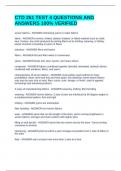CTD 261 TEST 4 QUESTIONS AND
ANSWERS 100% VERIFIED
woven fabrics - ANSWER-interlacing yarns to make fabrics
fabric - ANSWER-a woven, knitted, plaited, braided, or felted material such as cloth,
lace, hosiery, any cloth produced by joining fibers as by knitting, weaving, or felting,
planar structure consisting of yarns or fibers
solutions - ANSWER-films and foams
fibers - ANSWER-felt and fiber webs or nonwovens
yarns - ANSWER-braid, knit, lace, woven, and many others
composite - ANSWER-fabrics combined together (bonded, laminated, quilted); fabrics
combined with solutions, fibers, and yarns,
characteristics of woven fabrics - ANSWER-most widely used method w/ many
possibilities, fabric ravel and fray and have grain, low elasticity, same weave fabrics
may vary by yarn size or twist, fiber, count, color, design, or finish, used in apparel,
furnishings and industrial products
3 ways of manufacturing fabrics - ANSWER-weaving, knitting, fiber bonding
weaving - ANSWER-woven fabrics, 2 sets of yarn are interlaced at 90 degree angles in
a predetermined pattern, firm and rigid
knitting - ANSWER-yarns are interlooped
fiber bonding - ANSWER-non woven fabrics
warp - ANSWER-yarns that run the length of the loom, yarns running lengthwise in
woven fabrics; stronger and more uniform with higher twist
filling or weft (picks) - ANSWER-yarns that are woven across the loom. Yarns running
crosswise in wovens
interlacing - ANSWER-point at which a yarn changes its position from 1 side of fabric to
the other
float - ANSWER-yarn crosses over more than 1 yarn at a time
, thread count - ANSWER-the _____ ______ of a woven fabric is the sum of the number
of ends per inch and the number of picks per inch. Fabric counts range from a low of 8
to over 300
balanced, unbalanced - ANSWER-In a ________ weave the number of ends and picks
per inch are about equal, in an _________ weave, the number of ends per inch is
significantly greater than the number of picks per inch
loom - ANSWER-woven fabrics are produced on machines called...
capable of producing woven fabrics w/ structures that range from the simplest to most
complex
warp beam - ANSWER-warp yarns wound around large cylinder
harness - ANSWER-frame that holds heddles and controls basic weave
heddle - ANSWER-wires through which warp is threaded controls basic weave
shed - ANSWER-space created by the warp when some harnesses rise and lower
reed or batten - ANSWER-device pushes filling yarns in place
dent - ANSWER-space in reed through which warp is threaded
filling yarn insertion device - ANSWER-related to loom type, shuttle, rapier, gripper, or
jet carries filing through shed
balance - ANSWER-used to help name fabrics; this and count helps to predict slippage,
count is low more slippage in unbalanced ex. broadcloth
fabric weight - ANSWER-light, medium, heavy, helps to name the fabric and understand
its appropriate use
how you name a weave - ANSWER-fabric structure, fabric weight, yarn type, yarn
balance, finishes
filling - ANSWER-yarns interlaced w/ warp to create fabric cloth; often fancy or special
function yarns
weaving process/motion - ANSWER-1. shedding
2. picking
3. reed swings forward and beats filling yarn into the V where shed opens from
previously formed cloth (beating)
4. letting off, take-up, warp control
loom with shuttles - ANSWER-hand looms, power-operated looms,




